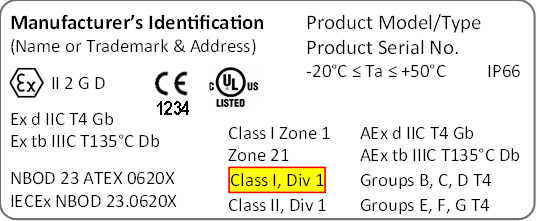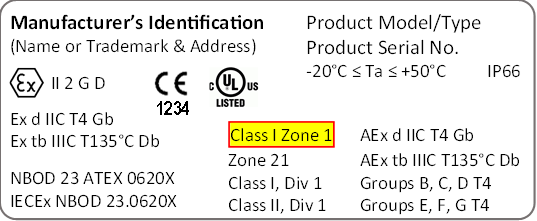The Drill Down, Issue #24: Hazardous Location Electrical Markings - Locations
 Introduction
Introduction
In this edition of the Drill Down series on Hazardous Location (HazLoc) electrical equipment markings, we will discuss National Fire Protection Association (NFPA) 70 (National Electric Code (NEC)) “Class and Division” and International Electrotechnical Commission (IEC) 60079-series “Zone” designations. Quotations from the referenced standards are shown in italicized font in this issue and bolded words denote “emphasis added”.
NFPA 70, Article 500
NFPA 70, (2017), Article 500 classifies hazardous locations by a Class and Division designation (figure 1), as defined at 500.5.
 |
| Figure 1: Equipment label with NFPA 70, Article 500 Class and Division markings indicated |
There are three different Classes (NFPA 70 (2017)):
Class I locations are those in which flammable gases, flammable liquid-produced vapors, or combustible liquid-produced vapors are or may be present in the air in quantities sufficient to produce explosive or ignitable mixtures (Article 500.5(B)).
Class II locations are those that are hazardous because of the presence of combustible dust (Article 500.5(C)).
Class III locations are those that are hazardous because of the presence of easily ignitable fibers… (Article 500.5(D)).
This Drill Down focuses on Class I locations for gases, but note that there may be areas on units or vessels subject to USCG oversight that may also be considered as Class II locations.
There are two Divisions per Class:
Class I, Division 1 (NFPA 70 (2017) 500.5(B)(1)) is a location in which:
1) ignitable concentrations of flammable gases, flammable liquid-produced vapors, or combustible liquid-produced vapors can exist under normal operating conditions, or
2) ignitable concentrations of such flammable gases, flammable liquid-produced vapors, or combustible liquids above their flashpoints may exist frequently because of repair or maintenance operations or because of leakage, or
3) breakdown or faulty operation of equipment or processes might release ignitable concentrations of flammable gases, flammable liquid-produced vapors, or combustible liquid-produced vapors and might also cause simultaneous failure of electrical equipment in such a way to directly cause the electrical equipment to become a source of ignition.
Class I, Division 2 (NFPA 70 (2017) 500.5(B)(2)) is a location:
1) in which volatile flammable gases, flammable liquid-produced vapors, or combustible liquid-produced vapors are handled, processed, or used, but in which the liquids, vapors, or gases will normally be confined within closed containers or closed systems from which they can escape only in case of accidental rupture or breakdown of such containers or systems or in case of abnormal operation of equipment, or
2) in which ignitable concentrations of flammable gases, flammable liquid-produced vapors, or combustible liquid-produced vapors are normally prevented by positive mechanical ventilation, and which might become hazardous through failure or abnormal operation of the ventilating equipment, or
3) that is adjacent to a Class I, Division 1 location, and to which ignitable concentrations of flammable gases, flammable liquid-produced vapors, or combustible liquid-produced vapors above their flash points might occasionally be communicated unless such communication is prevented by adequate positive-pressure ventilation from a source of clean air and effective safeguards against ventilation failure are provided.
NFPA 70, Article 505
NFPA 70, Article 505 utilizes a zone classification system (figure 2) consisting of three zone designations.
 |
| Figure 2: Equipment label with NFPA 70, Article 505 Class and Zone markings indicated |
Class I, Zones 0, 1, and 2 are defined as locations in which flammable gases or vapors are, or may be present in the air in
quantities sufficient to produce explosive or ignitable mixtures (NFPA 70 (2017) 505.5(B)).
Note that Zones 20, 21 and 22 (see figure 2) are associated with combustible dusts or ignitable flyings.
Class I, Zone 0 (NFPA 70 (2017) 505.5(B)(1)) is a location in which:
1) ignitable concentrations of flammable gases or vapors are present continuously; or
2) ignitable concentrations of flammable gases or vapors are present for long periods of time.
Class 1, Zone 1 (NFPA 70 (2017) 505.5(B)(2)) is a location:
1) in which ignitable concentrations of flammable gases or vapors are likely to exist under normal operating conditions; or
2) in which ignitable concentrations of flammable gases or vapors may exist frequently because of repair or maintenance operations of because of leakage; or
3) in which equipment is operated or processes are carried on, of such a nature that equipment breakdown or faulty operations could result in the release of ignitable concentrations of flammable gases or vapors and also cause simultaneous failure of electrical equipment to become a source of ignition; or
4) that is adjacent to a Class I, Zone 0 location from which ignitable concentrations of vapors could be communicated, unless communication is prevented by adequate positive pressure ventilation from a source of clean air and effective safeguards against ventilation failure are provided.
Class I, Zone 2 (NFPA 70 (2017) 505.5(B)(3)) is a location:
1) in which ignitable concentrations of flammable gases or vapors are not likely to occur in normal operation and, if they do occur, will exist only for a short period; or
2) in which volatile flammable liquids, flammable gases, or flammable vapors are handled, processed, or used but in which the liquids, gases, or vapors normally are confined within closed containers of closed systems from which they can escape, only as a result of accidental rupture or breakdown of the containers or system, or as a result of the abnormal operation of the equipment with which the liquids or gases are handled, processed, or used; or
3) in which ignitable concentrations of flammable gases or vapors normally are prevented by positive mechanical ventilation but which may become hazardous as a result of failure or abnormal operation of the ventilation equipment; or
4) that is adjacent to a Class I, Zone 1 location, from which ignitable concentrations of flammable gases or vapors could be communicated, unless such communication is prevented by adequate positive-pressure ventilation from a source of clean air and effective safeguards against ventilation failure are provided.
IEC 60079-Series
IEC utilizes a Zone system that consists of three Zone designations that are defined in IEC 60079-10-1 (not incorporated by reference through 46 CFR Subchapter J). Zones are not required as part of the IEC marking systems. However, to understand how the equipment corresponds to zone classification, zone definitions from IEC 60079-10-1 follow (46 CFR 110.15-1 and 2009 MODU Code 6.1 define the zones similarly):
Zone 0 is an area in which an explosive gas or vapor in mixture with air is continuously present or present for long periods.
Zone 1 is an area in which an explosive gas or vapor in mixture with air is likely to occur in normal operating conditions.
Zone 2 is an area in which an explosive gas or vapor in mixture with air is not likely to occur in normal operating conditions, or in which such a mixture, if it does occur, will only exist for a short time.
Although the zone is not a required marking component, specific IEC or “Ex” equipment may only be allowed in certain zones classifications. The Equipment Protection Level (EPL) consists of a two-letter designation (“Gb” in the IEC marking of “Ex d IIC T4 Gb” as shown in the previous figures) that serves to link “Ex” equipment to zones. Drill Down Issue #28 will examine EPLs, but in summary, the EPL marking provides a quick reference that equipment is safe for installation in the identified zone. This is indicated by the second, lower-case letter of the EPL where “a” equates to Zone 0, “b” to Zone 1, and “c” to Zone 2.
Conclusion
A hazardous location or area classification is based on the likelihood of a flammable/combustible hazard, as summarized in the table above. Electrical equipment intended for use in HazLocs is certified for location classification and type of hazard. The classification system utilized for a particular HazLoc is paramount to determining that equipment installed within the location meets or exceeds requirements for the location.
While some equipment may be tested and certified to comply with only one standard (NFPA 70, Article 500 for example), much of this equipment may be marked for all three systems (and more), as shown on the example labels.
The next Drill Down will address the “material groups” component of hazardous locations electrical equipment markings.